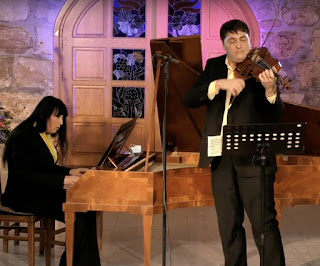 |
| Photo: Yoel Levy |
The program presented three early Beethoven works
in chronological order, opening with Quartet No.3 in C major, one of the
three WoO
36 quartets the composer penned in Bonn, these forming one of the master’s most
outstanding juvenilia. American musicologist and Beethoven specialist
Lewis Lockwood views them as “Beethoven’s first sign of greatness” and forming
“the beginning of a relationship to Mozart that remained a steady anchor for
Beethoven over the next ten years as he moved into his first artistic
maturity.” In his opening greetings and remarks, David Shemer spoke of
the effervescent and positive compositional style of the composer at age 14.
Performing the quartet at the Yellin House concert were Noam Schuss (JBO 1st
violinist), Tami Borenstein (viola), Lucia D’Anna Freij (‘cello) and David
Shemer (fortepiano). The
fortepiano and strings struck coherence and balance that gave the stage so
naturally to each solo - such as played by Schuss and Borenstein with
sensitivity in the (F major) Adagio movement, with the addition of some sparing
ornamentation from the keyboard. Rich in textures and contrasts, the outer
movements effused the joy of music-making, with the small occasional pause (Shemer) introducing a whimsical hint of suspense in the final Rondo Allegro movement.
Referring to the latter movement in the on-line master class, Maestro Parrott
hinted at its rustic character, commenting that he (Parrott) was “beginning to
see the insides of taverns”
 |
| Photo: Yoel Levy |
 |
| Photo: Yoel Levy |
Gili Rinot, known for her playing of historic clarinets, introduced Beethoven’s Septet in E flat major Op.20 (1799) to the listeners, referring to it as well written, entertaining and constantly drawing the listener into its readily comprehensible agenda. She spoke of it being a serenade, with the addition of some introductions, its hybrid textures being both symphonic and in the character of chamber music. During the second half of the 18th century, serenades and divertimentos represented the favourite “pop” style of music for social gatherings of the aristocracy and middle class. The Septet calls for an extremely unusual combination, the double bass included to lend weight to the ensemble and because it had traditionally been a member of the serenade ensemble. Written in the buoyant style of Mozart and Haydn and in the divertimento-type form of six short movements, its structure nevertheless emerges idiomatically that of Beethoven. Movements alternate between slow and fast tempi throughout. Performing at the JBO concert were Gili Rinot-clarinet, Matan Dagan-violin, Nina Loeterman-viola, Gilat Rotkop-bassoon, Barak Yeivin-horn, Yotam Haran-’cello and Eran Borovich-double bass. The artists gave articulate and finely-shaped expression to the work’s rich mix of antiphonal writing, florid wind solos and duets (there was much vivid dialogue between clarinet and violin) and virtuosic, concerto-like passages for solo violin, these altogether forming a musical canvas of both majesty and intimacy, brilliance and easeful composure. Added to these was the timbral warmth of the historic instruments and the inspiration Beethoven’s distinctive instrumental writing offers players. As was evident at this concert, we are now hearing some fine playing of early woodwind instruments on these shores, but how delightful it is to hear and see the natural horn played by local musicians! Kudos to Barak Yeivin for his commitment to this most challenging of instruments and for the pleasing results he produced on it. In 1802, Beethoven, in characteristic impatience, wrote the following to his publisher: “Send my septet out into the world a little faster – because the rabble is awaiting it”. It seems the public did not take offence at being referred to in this rather derogatory way.

No comments:
Post a Comment